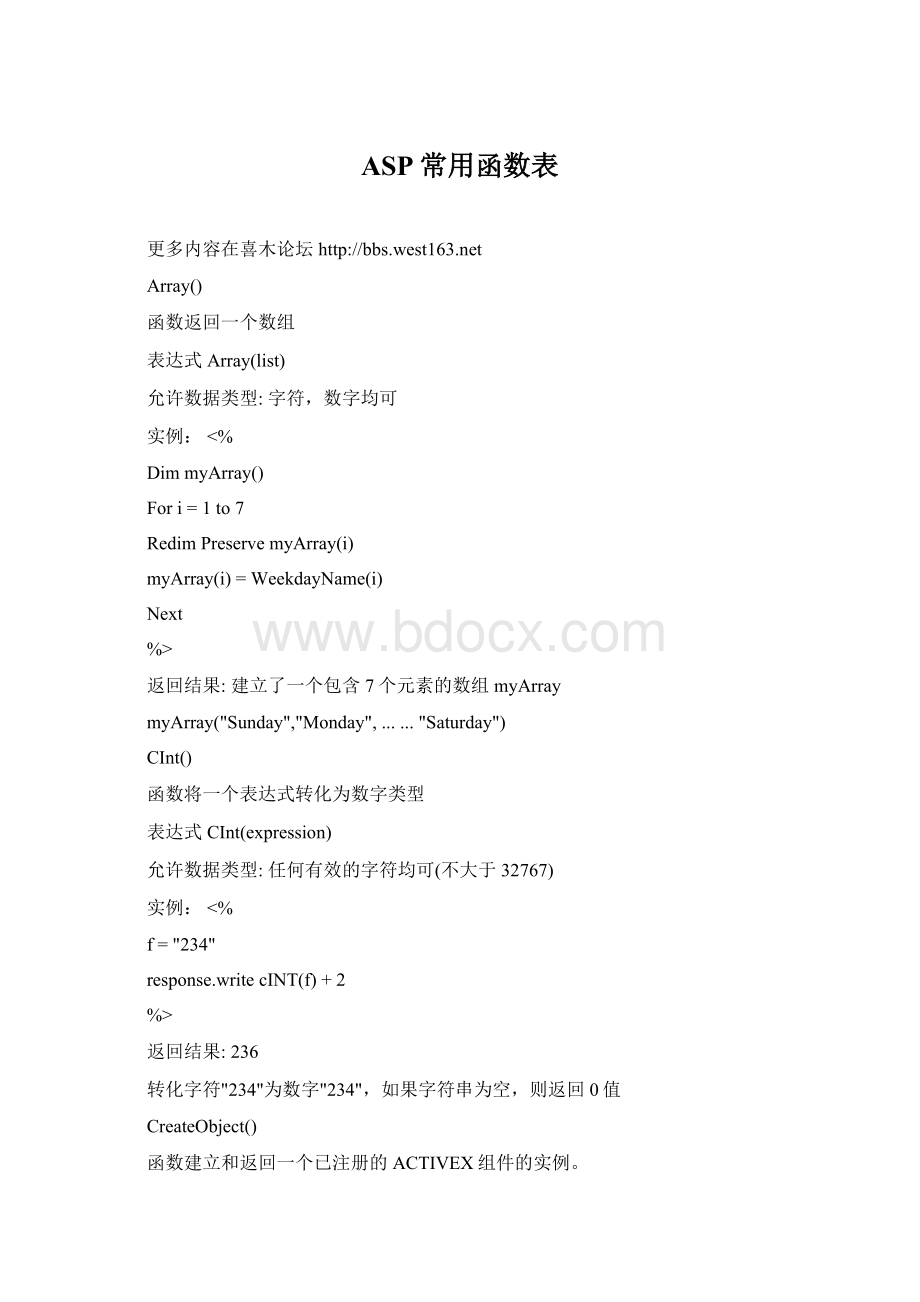ASP常用函数表.docx
《ASP常用函数表.docx》由会员分享,可在线阅读,更多相关《ASP常用函数表.docx(14页珍藏版)》请在冰豆网上搜索。

ASP常用函数表
更多内容在喜木论坛
Array()
函数返回一个数组
表达式 Array(list)
允许数据类型:
字符,数字均可
实例:
<%
Dim myArray()
For i = 1 to 7
Redim Preserve myArray(i)
myArray(i) = WeekdayName(i)
Next
%>
返回结果:
建立了一个包含7个元素的数组myArray
myArray("Sunday","Monday", ... ... "Saturday")
CInt()
函数将一个表达式转化为数字类型
表达式 CInt(expression)
允许数据类型:
任何有效的字符均可(不大于32767)
实例:
<%
f = "234"
response.write cINT(f) + 2
%>
返回结果:
236
转化字符"234"为数字"234",如果字符串为空,则返回0值
CreateObject()
函数建立和返回一个已注册的ACTIVEX组件的实例。
表达式 CreateObject(objName)
允许数据类型:
objName 是任何一个有效、已注册的ACTIVEX组件的名字.
实例:
<%
Set con = Server.CreateObject("ADODB.Connection")
%>
CStr()
函数转化一个表达式为字符串.
表达式 CStr(expression)
允许数据类型:
expression 是任何有效的表达式。
实例:
<%
s = 3 + 2
response.write "The 返回结果 is:
" & cStr(s)
%>
返回结果:
转化数字“5”为字符“5”。
Date()
函数返回当前系统日期.
表达式 Date()
允许数据类型:
None.
实例:
<%=Date%>
返回结果:
9/9/00
DateAdd()
函数返回一个被改变了的日期。
表达式 DateAdd(timeinterval,number,date)
允许数据类型:
timeinterval is the time interval to add;
number is amount of time intervals to add;
and date is the starting date.
实例:
<%
currentDate = #9/9/00#
newDate = DateAdd("m",3,currentDate)
response.write newDate
%>
<%
currentDate = #12:
34:
45 PM#
newDate = DateAdd("h",3,currentDate)
response.write newDate
%>
返回结果:
9/9/00
3:
34:
45 PM
"m" = "month";
"d" = "day";
If currentDate is in time format then,
"h" = "hour";
"s" = "second";
DateDiff()
函数返回两个日期之间的差值 。
表达式 DateDiff(timeinterval,date1,date2 [, firstdayofweek [, firstweekofyear]])
允许数据类型:
timeinterval 表示相隔时间的类型,如“M“表示“月”。
实例:
<%
fromDate = #9/9/00#
toDate = #1/1/2000#
response.write "There are " & _
DateDiff("d",fromDate,toDate) & _
" days to millenium from 9/9/00."
%>
返回结果:
从9/9/00 到2000年还有 150 天.
Day()
函数返回一个月的第几日 .
表达式 Day(date)
允许数据类型:
date 是任何有效的日期。
实例:
<%=Day(#9/9/00#)%>
返回结果:
9
formatCurrency()
函数返回表达式,此表达式已被格式化为货币值
表达式 formatCurrency(Expression [, Digit [, LeadingDigit [, Paren [, GroupDigit]]]])
允许数据类型:
Digit 指示小数点右侧显示位数的数值。
默认值为 -1,指示使用的是计算机的区域设置; LeadingDigit 三态常数,指示是否显示小数值小数点前面的零。
实例:
<%=formatCurrency(34.3456)%>
返回结果:
$34.35
formatDateTime()
函数返回表达式,此表达式已被格式化为日期或时间
表达式 formatDateTime(Date, [, Namedformat])
允许数据类型:
Namedformat 指示所使用的日期/时间格式的数值,如果省略,则使用 vbGeneralDate.
实例:
<%=formatDateTime("09/9/00", vbLongDate)%>
返回结果:
Sunday, September 09, 2000
formatNumber()
函数返回表达式,此表达式已被格式化为数值.
表达式 formatNumber(Expression [, Digit [, LeadingDigit [, Paren [, GroupDigit]]]])
允许数据类型:
Digit 指示小数点右侧显示位数的数值。
默认值为 -1,指示使用的是计算机的区域设置。
; LeadingDigit i指示小数点右侧显示位数的数值。
默认值为 -1,指示使用的是计算机的区域设置。
; Paren 指示小数点右侧显示位数的数值。
默认值为 -1,指示使用的是计算机的区域设置。
; GroupDigit i指示小数点右侧显示位数的数值。
默认值为 -1,指示使用的是计算机的区域设置。
.
实例:
<%=formatNumber(45.324567, 3)%>
返回结果:
45.325
formatPercent()
函数返回表达式,此表达式已被格式化为尾随有 % 符号的百分比(乘以 100 )。
(%)
表达式 formatPercent(Expression [, Digit [, LeadingDigit [, Paren [, GroupDigit]]]])
允许数据类型:
同上.
实例:
<%=formatPercent(0.45267, 3)%>
返回结果:
45.267%
Hour()
函数以24时返回小时数.
表达式 Hour(time)
允许数据类型:
实例:
<%=Hour(#4:
45:
34 PM#)%>
返回结果:
16
(Hour has been converted to 24-hour system)
Instr()
函数返回字符或字符串在另一个字符串中第一次出现的位置.
表达式 Instr([start, ] strToBeSearched, strSearchFor [, compare])
允许数据类型:
Start为搜索的起始值,strToBeSearched接受搜索的字符串 strSearchFor要搜索的字符.compare比较方式(详细见ASP常数)
实例:
<%
strText = "This is a test!
!
"
pos = Instr(strText, "a")
response.write pos
%>
返回结果:
9
InstrRev()
函数同上,只是从字符串的最后一个搜索起
表达式 InstrRev([start, ] strToBeSearched, strSearchFor [, compare])
允许数据类型:
同上.
实例:
<%
strText = "This is a test!
!
"
pos = InstrRev(strText, "s")
response.write pos
%>
返回结果:
13
Int()
函数返回数值类型,不四舍五入。
表达式 Int(number)
允许数据类型:
实例:
<%=INT(32.89)%>
返回结果:
32
IsArray()
函数判断一对象是否为数组,返回布尔值 .
表达式 IsArray(name)
实例:
<%
strTest = "Test!
"
response.write IsArray(strTest)
%>
返回结果:
False
IsDate()
函数判断一对象是否为日期,返回布尔值
表达式 IsDate(expression)
实例:
<%
strTest = "9/4/2000"
response.write IsDate(strTest)
%>
返回结果:
True
IsEmpty()
函数判断一对象是否初始化,返回布尔值.
表达式 IsEmpty(expression)
实例:
<%
Dim i
response.write IsEmpty(i)
%>
返回结果:
True
IsNull()
函数判断一对象是否为空,返回布尔值.
表达式 IsNull(expression)
实例:
<%
Dim i
response.write IsNull(i)
%>
返回结果:
False
IsNumeric()
函数判断一对象是否为数字,返回布尔值.
表达式 IsNumeric(expression)
实例:
<%
i = "345"
response.write IsNumeric(i)
%>
返回结果:
True
就算数字加了引号,ASP还是认为它是数字。
IsObject()
函数判断一对象是否为对象,返回布尔值.
表达式 IsObject(expression)
实例:
<%
Set con = Server.CreateObject("ADODB.Connection")
response.write IsObject(con)
%>
返回结果:
True
LBound()
函数返回指定数组维的最小可用下标.
表达式 Lbound(arrayname [, dimension])
实例:
<%
i = Array("Monday","Tuesday","Wednesday")
response.write LBound(i)
%>
返回结果:
0
LCase()
函数 返回字符串的小写形式
表达式 Lcase(string)
实例:
<%
strTest = "This is a test!
"
response.write LCase(strTest)
%>
返回结果:
this is a test!
Left()
函数返回字符串左边第length个字符以前的字符(含第length个字符).
表达式 Left(string, length)
实例:
<%
strTest = "This is a test!
"
response.write Left(strTest, 3)
%>
返回